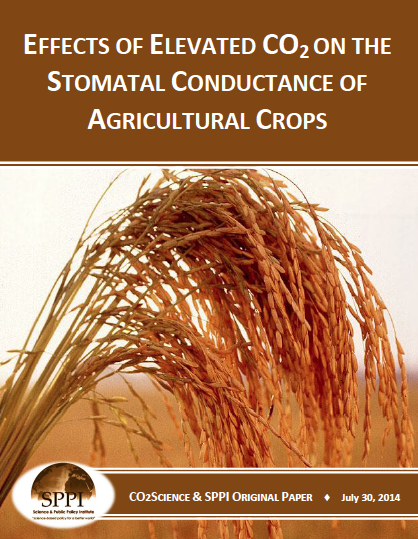News / Science & Technology
Effects of Elevated CO2 on the Stomatal Conductance of Agricultural Crops

As the air's CO2 content continues to rise, nearly all plants will respond by reducing their leaf stomatal apertures, through which water vapor exiting the leaf and carbon dioxide entering the leaf diffuse during transpiration and photosynthesis, respectively. This phenomenon typically leads to an increase in water use efficiency at elevated CO2 concentrations, because with more CO2 in the air, plants don't need to open their stomates as wide as they do at lower atmospheric CO2 concentrations to allow for sufficient inward diffusion of CO2 for use in photosynthesis. And as a consequence of this phenomenon, plants typically exhibit eductions in transpirational water loss, smaller yield losses attributable to the uptake of aerial pollutants, and increases in water-use efficiency. This summary document thus reviews some of the scientific literature pertaining to this important effect of elevated CO2 on the stomatal conductances of agricultural crops.
With respect to stomatal conductance itself, in the Free-Air-CO2-Enrichment (FACE) study of Garcia et al. (1998)1 a 190-ppm increase in the atmosphere's CO2 concentration reduced the average mid-day stomatal conductance in spring wheat by 28% over the entire growing season. Similarly, Hakala et al. (1999)2 reported that average stomatal conductances in spring wheat grown at twice-ambient levels of atmospheric CO2 were about 25% lower than those observed in ambiently-grown control plants, regardless of a concomitant exposure to an elevated air temperature treatment (3°C greater than ambient air temperature). Likewise, twice-ambient levels of CO2 generally decreased stomatal conductances in wheat, regardless of whether the elevated CO2 exposure was maintained on a 12- or 24-hour basis (Heagle et al., 19993). In addition, a 400-ppm increase in the air's CO2 concentration reduced stomatal conductances in hydroponically-grown peanuts by 44% (Stancielet al., 2000^4), while a 750-ppm CO2 increase reduced the stomatal conductances of a C4 maize crop by 71% (Maroco et al., 1999^5).
